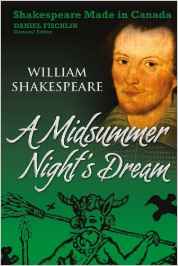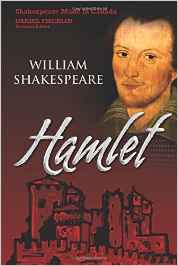| ________________
CM . . .
. Volume XXIII Number . . . .February 17, 2017
Note: in the following review, quotations from the two books will be indicated as “MND” (A Midsummer Night’s Dream), and “HAM” (Hamlet). “Shakespeare Made in Canada” is a new series, launched with the publication of two of the best-known plays: A Midsummer Night’s Dream and Hamlet. These two dramas often “book-end” a high school student’s study of Shakespeare: A Midsummer Night’s Dream is a comedy, frequently studied in Grades 9 or 10, while Hamlet, the eponymous tragedy of Hamlet, Prince of Denmark is a standard work for Grade 12 students. The cover of each book features the Sanders Portrait of Shakespeare, “the only painting in existence that is directly labeled as a portrait of Shakepeare”, (p. v, MSN and HAM) and which is currently owned by a Canadian, setting the stage for a “Made in Canada” perspective on Shakespeare’s work. The series’ title - Shakespeare Made in Canada - is intriguing, and both works are prefaced by the reflections of two Canadian actors, Martha Burns and Paul Gross. Burns’ retelling of her introduction to Shakespeare is a reminder that much of the power of the play is in its performance in a theatre:
As for Paul Gross – producer, director, writer, and recipient of the Order of Canada – his experience of playing the lead role in Hamlet during Stratford Festival’s 2000 season, was transformative, both professionally and personally:
Following the “Preface” to each work is an introductory essay which situates the history of performances of each of the two plays within a Canadian stage context. In his essay, “‘Such Shaping Fantasies’: A Midsummer Night’s Dream on the Canadian Stage”, Andrew Bretz, an instructor at the University of Guelph and Wilfred Laurier University, proposes that “the production history of A Midsummer Night’s Dream in Canada reflects the conflicted vision of the nation that developed both before and after Confederation” and that contemporary performances of the play “either tacitly or explicitly explore Canadian identity in terms of sexuality, race, colonial inheritance, and patriarchal domination.” (p. xii, MND) Similarly, in his prefatory essay, “‘The interim is mine’: Hamlet in Canada/Canada in Hamlet”, Daniel Fischlin, the series’ General Editor and University Research Chair and Professor of English and Theatre Studies at the University of Guelph, examines the play “from a variety of perspectives determined by the play’s relation to Canada – itself a contested national site of questioning over origins, identities, and futures yet to me made, meanings yet to be created.” (p. xii, HAM) His essay certainly covers an amazing range of presentations, from highly experimental 21st adaptations to the “parodic takedowns of high culture” (p. xv, HAM) undertaken by Canadian comedians Wayne & Shuster and the Royal Canadian Air Farce. These scholarly Introductions are well-researched and well-written, but they aren’t easy reading for anyone without a strong academic background in Shakespeare, as well as knowledge of Canadian history and culture, and are not likely to engage the interest of high school students studying either of the plays. However, both works include concise “Character Synopses”, boldfacing the names of all characters so that relationships between and amongst them are clear, and equally helpful is the “Plot Synopsis” which follows the “Character Synopses”, summarizing the scene-by-scene action, in each act of the two plays. Preceding the actual text of each play, there is “A Note on the Text”, providing information about the quarto and folio publications of both Hamlet and A Midsummer Night’s Dream, and explaining the challenges faced by editors of any new editions of Shakespearean text: [they] must look to both the quartos and the folio in the attempt to create a text that, as accurately as possible, represents what Shakespeare actually wrote and had played on the stage.” (pp. xlix –xl, HAM) In addition to the texts of the two plays, clearly-referenced footnotes clarify unfamiliar words, expressions, and provide explanatory material. The notes are comprehensive, referring to both print and electronic resources which were consulted in the compilation of the plays’ footnotes, and which are listed in the “Works Cited in the Introduction”. Rather unusual, I thought, was the section entitled “Ten Tips for Reading Shakespeare”, which offered insights into a diverse range of subjects, including concepts of social status, how words might have been pronounced in Shakespeare’s time, and Shakespeare’s rich use of Classical and Biblical references. These inaugural volumes in the “Shakespeare Made in Canada” series are reasonably priced, but they are scholarly editions, and for that reason, not the best choice for high school English teachers looking for new texts to replace their current editions of either A Midsummer Night’s Dream or Hamlet. The discourse level of the prefatory essays would challenge many first-year university students, and few high school students (or their teachers) would really be interested in the subtle textual differences in the extant quartos and folios. The “Shakespeare Made in Canada” series is the result of research undertaken in association with the Canadian Adaptations of Shakespeare Project at the University of Guelph, and, while it is undoubtedly the product of much hard work and tremendous commitment, I can’t recommend its acquisition as a classroom text, although teacher-librarians might consider buying a single copy if there is an English department member likely to have a highly academic approach to the teaching of Shakespeare. Recommended with Reservations. Joanne Peters, a former high school English teacher and teacher-librarian (retired), lives in Winnipeg, MB.
To comment
on this title or this review, send mail to cm@umanitoba.ca.
Copyright © the Manitoba Library Association. Reproduction for personal
use is permitted only if this copyright notice is maintained. Any
other reproduction is prohibited without permission.
Next Review | Table of Contents For This Issue - February 17, 2017 |

